Seguin homeowners concerned about indoor air quality should understand that visible mold isn't always an immediate danger, but hidden growth can be toxic. Mold remediation focuses on removing contaminated materials and restoring affected areas after addressing moisture issues, while mold inspection involves identifying and assessing mold development to guide targeted remediation. Homeowners should begin with a professional mold inspection for accurate risk mitigation, especially if there's potential HVAC contamination or water damage. This initial step saves time, money, and ensures effective, tailored remediation efforts based on the specific type and severity of mold found.
In Seguin, understanding the subtle signs of mold growth is crucial for maintaining a healthy home environment. This comprehensive guide delves into the critical interplay between HVAC systems and mold contamination, equipping homeowners with essential knowledge about mold inspection. Learn how to identify potential issues, the difference between remediation and inspection, and what steps Seguin residents should take to address or prevent mold-related problems, focusing on cost-effective solutions for peace of mind.
- Understanding Mold: A Homeowner's Guide to Contamination
- The Role of HVAC Systems in Mold Growth and Inspection
- Comparing Mold Remediation vs. Inspection: What Seguin Homeowners Need to Know
Understanding Mold: A Homeowner's Guide to Contamination

Understanding mold is crucial for Seguin homeowners looking to maintain a healthy living environment. Mold, a type of fungus, thrives in damp and humid conditions, often growing behind walls, in attics, or within HVAC systems. While some molds are harmless, others can produce toxic spores that pose significant health risks, especially for individuals with respiratory issues or compromised immune systems.
When it comes to Seguin homes, the difference between mold remediation and inspection is essential. A mold inspection involves a thorough evaluation of your property to identify mold growth and determine its extent. It’s the first step in addressing any contamination. In contrast, mold remediation focuses on removing and restoring affected areas after the source of moisture has been addressed. For homeowners, knowing when to seek professional help during each process is key to ensuring a safe and healthy living space.
The Role of HVAC Systems in Mold Growth and Inspection

HVAC (Heating, Ventilation, and Air Conditioning) systems play a significant role in both facilitating mold growth and ensuring its effective control within homes. These systems, while enhancing indoor comfort, can inadvertently distribute mold spores throughout a property, leading to potential health issues for Seguin homeowners. Mold thrives in dark, damp environments, and HVAC ducts often provide the perfect conditions—unseen corners of ductwork can remain moist, fostering mold development. Regular ventilation and proper sealing of these systems are crucial preventive measures.
When it comes to addressing mold-related concerns, understanding the difference between mold remediation and inspection is key. Mold inspection involves a thorough assessment to identify sources and extent of mold growth, aiding in targeted remediation efforts. In contrast, mold remediation focuses on the actual process of removing contaminated materials and restoring the environment. Homeowners should consider professional mold inspection as an initial step, especially if they suspect hidden mold or have experienced water intrusions, to determine whether remediation is necessary and avoid potential health risks associated with prolonged exposure to mold.
Comparing Mold Remediation vs. Inspection: What Seguin Homeowners Need to Know

When it comes to addressing potential HVAC contamination and mold issues in Seguin homes, understanding the difference between mold remediation and inspection is crucial for homeowners. Many residents may be tempted to jump straight into remediation, especially if visible mold growth is present. However, a thorough inspection is often the first step, as it helps identify the source and extent of the problem.
Mold remediation focuses on removing contaminated materials and restoring the affected area, while an inspection aims to assess the situation, pinpoint mold sources, and determine if remediation is required. For Seguin homeowners, having a professional inspect their HVAC system can save time and money in the long run by preventing unnecessary remediation efforts. An inspection provides valuable insights into the presence, type, and severity of mold, ensuring that any subsequent remediation work is targeted and effective.
When faced with potential HVAC contamination or mold issues in Seguin, it’s crucial to understand the distinction between mold remediation and inspection. While both are essential components of maintaining a healthy home environment, each serves a unique purpose. Mold inspection helps identify the extent and source of moisture problems and potential mold growth, guiding subsequent remediation efforts. In contrast, mold remediation involves removing contaminated materials and restoring your HVAC system to prevent future mold development. Knowing when to seek professional help for either task is key for Seguin homeowners aiming to protect their investment and ensure a safe living space.
